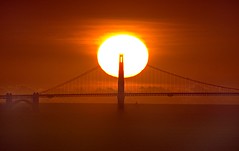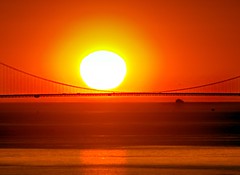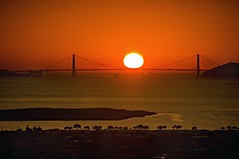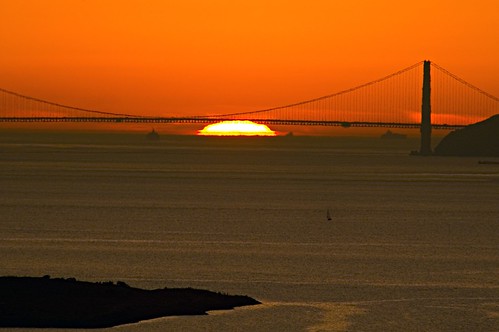 |
|
 |
|
 |
I photographed the sun, and did not blink. No King Canute, who tried to stop the waves but the waves wouldn’t listen, this project worried me. The sun is more powerful than my eyes. That’s obvious.
I think there’s nothing worse for a visual person to imagine than damaging one’s vision. Photographing the sun over a period of time through long lens (600mm in 35mm terms) obviously has that potential. Well, maybe harm to one’s kids is worse.
Excited by a photo I caught of the sun and south tower of the Golden Gate Bridge, I decided to try to catch the sun precisely in the middle of the Golden Gate span. At this time of year, the direction that the sun sets change substantially night to night–so the change from south tower to center span would be about a week. Of course, this assumes that you photograph the sunset from one position, and when the sun bisects the bridge depends on the location of that position. Your location and mileage will vary.
In reality, capturing the photograph I wanted meant spending every night for about ten days photographing sunset from one vantage point (Indian Rock). Not an onerous task, but I did want to be careful of my eyes. (Besides common sense, you’ll find a warning in the documentation for almost any reasonably long lens not to look through it at the sun.) After all, I am passionate about photography, but no image is worth risking oneself.
I figured that I would be photographing the setting sun (not the middle-of-the-day sun), which would make the project less dangerous. I wore my sunglasses with UV protection. And I glanced as little as possible into the viewfinder, just using it to set the shots up. Instead, I used the LCD display to get feedback about the photographs as I took them, and adjusted accordingly. (I could do this because I had the camera on a tripod.)
Ironically, close-up photography of this sun has a double involvement with fried egg: you don’t want to fry your own eyeballs, and you don’t want the sun to fry out the highlights in your photograph (if it does, it kind of looks like a drippy fried egg in the sky).
I thought I was pretty careful. But a day or two after the final session in the series I developed vision problems. My eyes felt funny and gritty, my vision was a bit blurred, and I started getting headaches.
Had I fried my eyes? A couple of pieces on the Internet made me think I might have damaged my eyes. (Here’s the WebMD article.) The symptoms seemed right (but then again when I read a set of symptoms on the web I can imagine myself having all kinds of bizarre diseases!). Also, I couldn’t see how both my eyes had been damaged since I only looked through my camera with my right eye.
To make a long story somewhat shorter, my othamologist didn’t find any damage, but he did find some inflammation due to some minor infection or allergy. Steroid eye drops should clear it up in no time. I may also need a stronger prescription for my eye glasses.
I am greatly relieved.
For my future reference, and yours, you can look carefully at the sun through some special filters with safety. Here’s an article by an optometry professor explaining the options (intended for amateur astronomers and eclipse observations). The easiest to get sounds like a pair of welder’s glasses with a #14 filter. I’m going to get me a pair before I photograph that next up close and personal sunset!
Here are the original posts with quite of few of my photographs of the sun and bridge:

shixing9
7 Oct 2007The color of the sun in your pictures appear white, similar to the sunset pictures
I took the other day although the color of the sun was bright red. Why did the sun’s red color becomes white in the picture? Is it possible to capture the “real” red color of the sun?
Thanks
Harold Davis
7 Oct 2007@shixing9: The problem is the relative brightness of the sun and everything else. If you expose for the sun, you get some colors in the sun, including an occasional red (here’s an example), but the background will go very dark ost of the time. An exposure that shows detail in the landscape will necessarily overexpose the sun, blowing it out and causing the white look.
If you want to try for a colored sun, try underexposing your images relative tot he overall landscape by 4 or more stops.